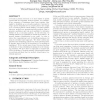Free Online Productivity Tools
i2Speak
i2Symbol
i2OCR
iTex2Img
iWeb2Print
iWeb2Shot
i2Type
iPdf2Split
iPdf2Merge
i2Bopomofo
i2Arabic
i2Style
i2Image
i2PDF
iLatex2Rtf
Sci2ools
GIS
2008
ACM
2008
ACM
Density based co-location pattern discovery
Co-location pattern discovery is to find classes of spatial objects that are frequently located together. For example, if two categories of businesses often locate together, they might be identified as a co-location pattern; if several biologic species frequently live in nearby places, they might be a co-location pattern. Most existing co-location pattern discovery methods are generate-and-test methods, that is, generate candidates, and test each candidate to determine whether it is a co-location pattern. In the test step, we identify instances of a candidate to obtain its prevalence. In general, instance identification is very costly. In order to reduce the computational cost of identifying instances, we propose a density based approach. We divide objects into partitions and identifying instances in dense partitions first. A dynamic upper bound of the prevalence for a candidate is maintained. If the current upper bound becomes less than a threshold, we stop identifying its instances ...
Co-location Pattern Discovery | Database | GIS 2008 | Keywords Co-location Patterns | Most Existing Co-location |
| Added | 09 Nov 2009 |
| Updated | 09 Nov 2009 |
| Type | Conference |
| Year | 2008 |
| Where | GIS |
| Authors | Xiangye Xiao, Xing Xie, Qiong Luo, Wei-Ying Ma |
Comments (0)

